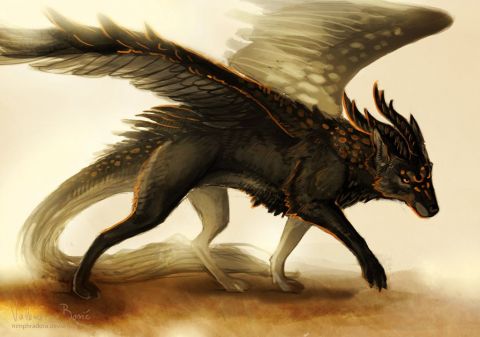Sharvalain
Contents
Fast Facts
Height: 3' to 4'3 feet (Adults, at shoulder)
Weight: 80 to 200 lbs (Male), 73 to 176 lbs (Female)
Length: 4'2 to 7 feet (Adult)
Diet: Mostly carnivorous, can digest plant matter if necessary but dangerous and painful in large amounts. Typically avoid.
Rarity: Highly Uncommon to Rare, depending on the area
Trainability/Taming: Sharvalains tend to be difficult to train as most are stubborn. Generally, it takes an Expert trainer and handler at the very least, and even it can still be difficult.
Appearance and Biology
The Sharvalain is known for a couple of distinctive traits. The first of which being their immediate wolf life apperance. While slightly larger than a wolf, their apperance is mostly that of a wolf. The second feature someone might be tempted to point out is their resemblance to dragons. The Sharvalain are not to be mistaken for dragons in any sense of the word, though they are a relative in the physical sense. If very, very distantly removed.
A Sharvalain typically has a couple of traits one could associate with dragons. Such as the horns, their wings, and the presence of scales dotting their bodies. These scales offer some protection, but it's very little. They aren't going to protect a Sharvalain from a well-crafted arrow or sword. They're a bit more durable than straight-up skin, but not by much and thick enough fur can do the job just as well. As a whole, the body of the Sharvalain isn't that durable in the slightest. They can survive a wide range of climates and temperatures, and they have very powerful jaws which can cause damage to predators, but they themselves have hollow bones and a weaker physical aptitude. They are still predators, but they aren't physically as powerful as one might assume at a first glance.
If anything, their biggest assets when it comes to their own protection are their horns and their wings. Their horns are the most durable thing on their body, and they can use these horns to absorb attacks that would otherwise shatter them. That being said, their horns are still placed on their head which makes attempting to block blows a danger in and our itself, and there's still the risk that the horns won't be able to absorb the full shock of the impact resulting in injury or even brain damage, as the horns are protrusions of the skull. Their wings are the most person muscle in their body, used to escape danger at a moment's notice. Sharvalain's also hunt by swooping like birds of prey, which means losing their wings can be lethal to the Sharvalain. The limb of the wing is covered in fur and scale, and it's the only place on the body where the scales are actually powerful enough to absorb damage. As the wings are so vital, the scales here have evolved to be much tougher than the scales on the rest of the body.
The wing portion that allows for flight is made up of feathers, and often these feathers are reminiscent to that of the feather based biology of birds. Much like birds, they do molt, but the feathers of a Sharvalain are the fastest thing to grow back on their body thanks to the priority of these feathers. A lost feather only takes about a week to grow back if it's fully lost. If the feather is clipped it must either be removed by the Sharvalain, or the Sharvalain must wait until the feather molts and regrows. A clipped feather is a danger as it can hinder or render fight impossible, which is why Sharvalain will often rip out feathers that are starting to show too much wear. The follicles that grow these feathers are hardy enough that ripping out the feather won't cause enough damage to hinder regrowth.
The fur of the Sharvalain typically comes in the normal shades the pelt of a wolf might with a couple added colors that might benefit camouflage. These are usually rare and present in extremely small populations like those that live in a jungle developing certain colors and patterns to adapt. Regarding eye color, the eyes of a Sharvalain can come in a wide variety.
On the topic of the eyes of the Sharvalain, they're known to have three eyelids. The outer eyelid is like the normal eyelid of a humanoid or any regular animal. The second eyelid is closed during flight to protect against wind and dangers to the eye, this eyelid is see-through. The third eyelid is special in that it can trap light. The Sharvalain have colored vision, which could put their night vision in jeopardy. Using this third eyelid, they're able to close it while it's bright out and it causes a sense of faux night vision. While still dim, this gives the Sharvalain the ability to partially see in the dark better than a lot of other creatures and still observe color better than creatures with true night vision.
The final detail of note regarding the Sharvalain is their ability to vocalize. The Sharvalain possess a much larger vocal range than most other creatures on Atharen, their vocal cords are finely tuned to produce noises both above and below hearing frequency for most other creatures. The drawback of this is that Sharvalain struggle to vocalize at a very loud volume. Normal communication sounds like a human whispering and trying to speak loudly sounds nothing like close to the volume of a dog barking. To counteract this, Sharvalain have extremely delicate hearing which is both a benefit and a drawback in loud places, hence why they tend to seek out quiet habitats far from mortal races.
